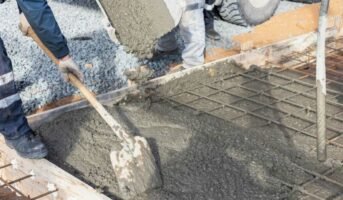What is Pile Cap?
- Pile cap, which is a thick, square structure made of concrete that rests atop the pile (a pile of wood or concrete), provides the system’s foundation with stability.
- The total weight of the superstructure is transferred from one to another pile cap, giving you a reliable bearing capacity.
- A raft foundation, which also has a building that resembles concrete blocks, has a similar construction to the pile top.
Importance of Pile Cap
- When the soil beneath the structure cannot support a spread footing, the load is transferred to deeper, firmer strata using piles. Piles may also be used to move the load below the level of such influence in areas where seasonal variations significantly impact the soil.
- The capacity of a pile to support loads is equal to the product of its end-bearing capacity and its capacity to reduce skin friction with the earth around it. Depending on the terrain, everyone makes a different kind of contribution. For instance, sandier soils have lower skin friction resistance than clayey soils.
- A series of equal piles are typically utilised when the load that must be reinforced surpasses the bearing capability of an individual pile.
- To disperse the load among the group piles, the group is capped by a spread footing or a cap. Instead of providing separate caps with several closely spaced piles, it might be more cost-effective to supply only one huge cap, making a piled raft.
Design structure of Pile Cap
The pile cap looks like a mat that rests over the pile cluster. According to IS 2911-2010, the pile cap is kept in such a way that the column load is broadened out at a 45° angle from the apex of the cap.
Presumptions about the design structure of Pile Cap
- The pile cap needs to be firmly fixed to the building.
- Even though piles are only slightly elastic columns, some deformations will still be present, and we must measure them in the plan.
- To protect against the winding that can occur in a pile, pile heads should pivot along with the pile cap.
Limitations of design structure of Pile Cap
- Outline and shape of the pile cap.
- The pile cap contains an amount of steel.
- Reinforcement placed in the pile cap.
- Depth of the pile.
see also about: pile concrete
Pile Cap construction: Tips and best practices
- It would be significantly preferred if you provided 150 mm, but the facet of the pile is regarded by the suspended section of the pile cap as not less than 100 mm.
- The reinforcement of the pile top needs to be thicker since the strengthening of the columns could protrude and overlap it.
- The clear cover must be greater than 40 mm in pile cap construction.
- The ratio of the pile cap’s extent to thickness must not be greater than 5. The pile cap needs to be quite stiff to transfer the load to the pile section and move it downward.
- The thickness is reduced to 300 mm on the edges and cannot be less than 500 mm in the centre.
- The pile must extend 50 millimetres or more into the pile cap.
- Concrete with a minimum thickness of 75 mm covers the top of the pile cap.
know about: Piling foundation
Structure of Pile Cap
A sturdy cylinder construction, the pile, often supports loads of superstructure and transfers them to the subsoil. A little distance above the pile, the pile cap is built.
Pile foundation is used in the following situations; those are-
- A pile foundation construction is used when the subsoil is weaker, but the superstructure load is too great to be supported by shallow footing.
- We need to utilise a pile foundation when the structure’s weight is too great, such as with a bridge, water tank, high-rise building, etc.
Piles are mainly two types; those are-
- End-bearing Pile: In this kind of pile, the end piece is supported by hard beginnings buried beneath the surface. This particular pile serves as a vertical column.
- Friction Pile: When the structural load is too great, but the subsoil is not too hard, and we cannot locate hard strata at a sufficient depth, we must employ a friction pile. Because it increases the friction’s surface area, this form of pile dia is too large.
Pile Cap reinforcement for maximum strength
For maximum strength, all piles shall be reinforced with minimum 4 longitudinal steel bars that has an area of around 1.25 percent and not exceeding 4.0 percent of the gross cross sectional area of the pile
Spacing and skin friction in Pile group construction
The pile foundation’s design and its effectiveness and capacity in any structure are determined by the pile foundation spacing and skin friction in a pile group. A pile foundation’s primary function is to allow load transmission across weak soil strata (soil strata with poor bearing capacity).
When soil strata at an acceptable depth are weak, it is determined that a pile foundation is a cost-effective option. The pile foundation must extend into strata with sufficient bearing capacity. Depending on the situation, install a cluster of piles in order to increase bearing capacity.
The piles are also used when weight needs to be transmitted over a depth by a particular amount of frictional resistance caused by skin contact with the surrounding soil. It provides sufficient shear resistance.
Additionally, using a pile foundation helps to avoid building cofferdams to support underwater piers. In this location, the pile will transport the weight to a significant supporting medium below a considerable water depth.
Raker piles are the ones that are driven at an angle. These are used to counteract forces that are inclined. The result of horizontal thrust is the inclined forces.
Factors of Pile Cap
The framework of the pile cap is dependent on several factors, including
-
Shape and Size
Depending on the number of piles and the distance between two piles, the form and size will change.
For example, A triangular pile cap for three heaps, a hexagonal pile cap for six to seven piles, a rectangle pile cap for other pile sizes, etc.
Due to the pile’s compact positioning, this pile cap style is utilised to reduce the pile cap area.
There shouldn’t be more than 150 mm of pile top overhang. This bare minimum area offers enough length to
- The curve in tension reinforcement has a big radius.
- Make sure that enough reinforcement is covered.
- Must satisfy construction tolerance.
Designing pile caps for deep foundations
Another section of the pile cap foundation works is the depth of the pile cap. The following standards are taken into account:
- Shrinkage of clay
- The pile cap’s shear capacity
- Pile anchorage
- A natural occurrence such as a frost attack
- The water table of the ground surface.
The pile cap has a significantly greater depth than pad footing, which explains why it can support more concentrated loads.
Pile cap depth for different pile diameters-
| Pile Diameter (mm) | Depth of Pile (mm) |
| 300 | 700 |
| 350 | 800 |
| 400 | 900 |
| 450 | 1000 |
| 500 | 1100 |
| 550 | 1200 |
| 600 | 1400 |
| 750 | 1800 |
Conclusion
For a well-made, substantial house, you need to build numerous pile caps. In addition to providing a more extensive area for distributing the building load onto the piles, pile caps provide a solid foundation. They function similarly to piled raft foundations, which rest a concrete slab on potentially unstable soil over a collection of piles. A single pile cap might be necessary if your column is made of high-strength concrete and your pile is made of relatively low-strength concrete. If the pile is significantly greater than the column in comparison, load transfer is also made more difficult. With all the above information, Build strong pile caps for your antifragile house!
FAQs
Is a pile cap a slab?
A pile cap is termed as a reinforced concrete structure built on the awning of a cluster of foundation stacks to displace or scatter the load they are to hold evenly.
How thick should a pile cap be?
Generally, its thickness should not be less than 500mm, which may be reduced to 300mm at the free edges. 6. The piles should be at least 50mm into the pile cap.
How many piles are in a pile cap?
Pile caps are made to keep the pile and structure jointly at the bottom level or below the bottom level while moving sacks of the superstructure to the floor. In general, pile caps are built to join one pile or more piles.
What is a pile cap made of?
Long steel bars along with longitudinal protrusions are used between the piles held in shape by thinner tie wires. Timber is attached around the perimeter, once laid to enclose the wet concrete mixture.
How deep should pile foundations be?
Usually, a profundity of 700mm is good enough, as long as the ground has enough bearing capacity. If the water table is far above the ground (for instance, if the gravel is sunken), the tolerance capacity will be halved, so keeping the foundations as high as possible is essential.
| Got any questions or point of view on our article? We would love to hear from you.Write to our Editor-in-Chief Jhumur Ghosh at jhumur.ghosh1@housing.com |
Housing News Desk is the news desk of leading online real estate portal, Housing.com. Housing News Desk focuses on a variety of topics such as real estate laws, taxes, current news, property trends, home loans, rentals, décor, green homes, home improvement, etc. The main objective of the news desk, is to cover the real estate sector from the perspective of providing information that is useful to the end-user.
Facebook: https://www.facebook.com/housing.com/
Twitter: https://twitter.com/Housing
Email: editor@housing.com











